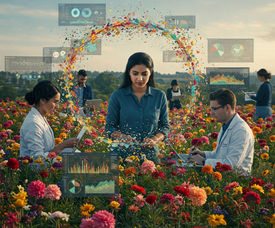AI-Powered Virtual Assistants in Our Homes
- Tretyak
- Apr 8
- 4 min read

Remember the days of flipping through a phonebook or meticulously managing your schedule with a paper planner? Technology has come a long way, and now, we have AI-powered virtual assistants seamlessly integrated into our daily lives. These digital concierges are revolutionizing how we interact with our homes and the world around us, offering a hyperconnected symphony of personalized service.
What are Virtual Assistants? A Deep Dive into the Algorithmic Butler
At their core, virtual assistants are sophisticated software programs that utilize artificial intelligence (AI) to understand and respond to human language. They're not just simple command-takers; they are evolving into intelligent companions, capable of learning our preferences, anticipating our needs, and seamlessly integrating into our lives.
How do they work? The Algorithmic Symphony Unveiled
Virtual assistants leverage a complex interplay of technologies:
Natural Language Processing (NLP): This is the foundation of their understanding. NLP enables the assistant to process and interpret human language in its natural form, including nuances, slang, idioms, and even humor. Advanced NLP models are even beginning to understand the emotional tone behind our words.
Machine Learning (ML): This is where the "learning" happens. ML algorithms allow the assistant to learn from user interactions, improving its responses and becoming more personalized over time. The more we use them, the better they understand us.
Artificial Intelligence (AI): This is the engine that drives the assistant's ability to reason, make decisions, and perform complex tasks. AI allows them to go beyond simple commands and engage in more sophisticated interactions.
Speech Recognition: This technology converts spoken language into text that the assistant can understand.
Text-to-Speech (TTS): This converts the assistant's responses back into spoken language.
The Impact on Our Lives: A Hyperconnected Ecosystem of Convenience and Control
Virtual assistants are transforming our daily lives in profound ways:
Increased Efficiency: They automate mundane tasks, freeing up time and mental energy for more important and creative activities. Imagine an assistant that manages your grocery list, reorders supplies when they run low, or schedules appointments.
Enhanced Convenience: They provide quick and easy access to information and services, often with just a voice command. Need to know the weather, find a restaurant, or book a flight? Your assistant can handle it.
Improved Accessibility: They make technology more accessible to people with disabilities, offering hands-free control and alternative input methods.
Enhanced Safety and Security: They can be used to monitor homes, control security systems, and even assist in emergency situations. Imagine an assistant that can detect a fall and automatically call for help, or alert you to a potential break-in.
Personalized Entertainment: They can curate music playlists, recommend movies, and even tell stories, providing tailored entertainment experiences.
Seamless Smart Home Integration: They act as a central hub for controlling smart home devices, allowing you to manage lighting, temperature, appliances, and more with your voice.
Examples of Virtual Assistants in Action:
General-Purpose Assistants:
Google Assistant: Integrated into Android devices and Google Home speakers, it offers a wide range of functionalities, from setting reminders to controlling smart home devices.
Amazon Alexa: Found in Amazon Echo devices, it excels at shopping, playing music, and controlling smart home devices.
Apple Siri: Built into Apple devices, it's known for its natural language understanding and integration with the Apple ecosystem.
Specialized Assistants:
Customer service chatbots: AI-powered chatbots are increasingly used to handle customer inquiries online, providing instant support and freeing up human agents for more complex issues.
Healthcare-focused apps: Virtual assistants are being developed to help patients manage their medications, track their symptoms, and communicate with their doctors.
Financial assistants: AI-powered tools can help with budgeting, saving, and investing.
The Future of Virtual Assistants: A Glimpse into the Algorithmic Frontier
The future of virtual assistants is brimming with potential. As AI technology continues to advance, we can expect even more sophisticated, personalized, and proactive experiences. Here are some potential developments:
Proactive Assistance: Assistants that anticipate your needs and proactively offer solutions, even before you ask. Imagine an assistant that reminds you to leave for an appointment based on traffic conditions, or suggests a recipe based on the ingredients you have on hand.
Enhanced Emotional Intelligence (Affective Computing): Assistants that can understand and respond to your emotional state, offering empathy and personalized support.
Greater Integration with the Physical World: Assistants that seamlessly control and interact with the devices and systems around you, blurring the lines between the digital and physical realms. Imagine an assistant that can recognize your face and automatically adjust the lighting and temperature in your home, or order a taxi when you're ready to leave.
Personalized Education and Training: Assistants that can provide customized learning experiences, adapting to your individual learning style and pace.
Creative Collaboration: Assistants that can collaborate with you on creative tasks, such as writing music, designing art, or even developing software.
Ethical Considerations: Navigating the Algorithmic Landscape Responsibly
As virtual assistants become more integrated into our lives, it's crucial to address the ethical implications:
Data Privacy: Ensuring the security and privacy of the vast amounts of personal data collected by virtual assistants.
Algorithmic Bias: Preventing bias in the algorithms that power virtual assistants, ensuring fair and equitable treatment for all users.
Job Displacement: Considering the potential impact on jobs in areas like customer service and administrative support.
Over-Reliance: Avoiding excessive dependence on virtual assistants and maintaining our own skills and abilities.
Transparency and Explainability: Understanding how virtual assistants make decisions and ensuring that their actions are transparent and explainable.
In Conclusion: The Algorithmic Symphony of Personalized Service
Virtual assistants are a testament to the transformative power of AI. By making our lives more efficient, convenient, enjoyable, and even safer, they are paving the way for a future where technology truly serves humanity, creating a hyperconnected symphony of personalized service that enhances our lives in countless ways.































































































Commenti